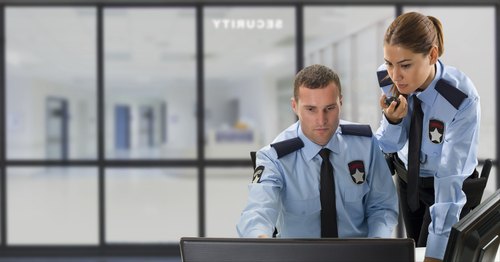Empowering Your Business with Ironclad Corporate Security Measures
Empowering Your Business with Ironclad Corporate Security Measures
Blog Article
From Cybersecurity to Physical Steps: Strengthening Business Safety And Security in a Changing World
By combining the strengths of both cybersecurity and physical safety and security, business can produce a detailed protection strategy that attends to the varied variety of risks they face. In this conversation, we will certainly check out the altering threat landscape, the need to incorporate cybersecurity and physical safety, the execution of multi-factor authentication steps, the significance of employee recognition and training, and the adaptation of safety steps for remote workforces. By checking out these crucial locations, we will gain beneficial insights into just how companies can strengthen their company protection in an ever-changing globe.
Comprehending the Changing Hazard Landscape
The evolving nature of the modern-day world necessitates an extensive understanding of the altering threat landscape for reliable corporate safety and security. In today's interconnected and digital age, risks to company protection have become a lot more intricate and sophisticated. As modern technology developments and services end up being significantly reliant on electronic infrastructure, the potential for cyberattacks, information violations, and other protection violations has considerably raised. It is important for organizations to remain informed and adapt their safety measures to resolve these developing dangers.
One trick facet of comprehending the transforming hazard landscape is identifying the various types of risks that organizations face. Additionally, physical threats such as theft, vandalism, and business espionage remain widespread issues for services.
Surveillance and examining the hazard landscape is crucial in order to recognize possible risks and vulnerabilities. This entails remaining updated on the most recent cybersecurity fads, examining risk intelligence reports, and performing routine danger evaluations. By understanding the transforming hazard landscape, organizations can proactively execute appropriate security actions to alleviate threats and shield their possessions, credibility, and stakeholders.
Integrating Cybersecurity and Physical Protection
Incorporating cybersecurity and physical security is critical for detailed business security in today's interconnected and electronic landscape. As companies significantly depend on technology and interconnected systems, the borders between physical and cyber hazards are coming to be blurred. To successfully safeguard against these risks, an all natural method that incorporates both cybersecurity and physical safety and security actions is essential.
Cybersecurity concentrates on protecting digital assets, such as data, systems, and networks, from unauthorized gain access to, disruption, and burglary. Physical safety, on the other hand, incorporates steps to secure physical assets, people, and centers from threats and susceptabilities. By integrating these two domain names, organizations can deal with vulnerabilities and dangers from both digital and physical angles, therefore enhancing their overall protection position.
The combination of these 2 self-controls permits a much more detailed understanding of protection threats and makes it possible for a unified response to events. As an example, physical gain access to controls can be enhanced by integrating them with cybersecurity procedures, such as two-factor authentication or biometric identification. Likewise, cybersecurity steps can be matched by physical safety measures, such as monitoring cams, alarms, and protected accessibility points.

Executing Multi-Factor Verification Procedures
As organizations significantly prioritize extensive protection steps, one reliable method is the application of multi-factor verification measures. Multi-factor verification (MFA) is a safety and security approach that calls for users to supply several types of recognition to access a system or application. This strategy includes an additional layer of defense by incorporating something the user knows, such as a password, with something they have, like a fingerprint or a security token.
By implementing MFA, organizations can substantially boost their safety and security posture - corporate security. Standard password-based verification has its restrictions, as passwords can be conveniently endangered or forgotten. MFA reduces these dangers by adding an extra verification factor, making it harder for unauthorized people to access to sensitive information
There are numerous types of multi-factor verification techniques offered, including biometric authentication, SMS-based verification codes, and hardware tokens. Organizations require to analyze their specific requirements and choose one of the most ideal MFA option for their requirements.
Nonetheless, the implementation of MFA need to be meticulously planned and implemented. It is essential to strike a balance in between security and use to stop individual irritation and resistance. Organizations must likewise consider possible compatibility problems and supply adequate training and support to ensure a smooth change.
Enhancing Worker Understanding and Training
To reinforce business safety and security, companies need to focus on improving staff member our website understanding and training. In today's quickly advancing threat landscape, employees play an essential function in securing a company's sensitive details and possessions. However, lots of safety and security violations occur because of human error or absence of awareness. For that reason, organizations require to buy detailed training programs to enlighten their employees concerning potential dangers and the very best practices for reducing them.
Efficient staff member recognition and training programs need to cover a large range of topics, including data protection, phishing strikes, social design, password hygiene, and physical protection measures. These programs try this site must be customized to the details demands and duties of different worker functions within the organization. Regular training simulations, sessions, and workshops can help employees develop the necessary abilities and understanding to recognize and react to security hazards effectively.
Additionally, organizations need to urge a culture of security understanding and give recurring updates and suggestions to maintain employees educated concerning the current risks and reduction methods. This can be done via inner interaction channels, such as e-newsletters, intranet portals, and e-mail projects. By promoting a security-conscious workforce, organizations can considerably decrease the likelihood of security events and shield their important possessions from unauthorized gain access to or concession.

Adapting Security Steps for Remote Workforce
Adjusting company safety and security procedures to suit a remote labor force is important in guaranteeing the protection of sensitive info and possessions (corporate security). With the raising fad of remote job, organizations have to execute suitable safety procedures to minimize the risks connected with this new method of working
One vital facet of adjusting safety procedures for remote job is establishing safe interaction networks. Encrypted messaging systems and online private networks (VPNs) can assist secure delicate info and avoid unauthorized accessibility. Additionally, organizations need to apply making use of strong passwords and multi-factor verification to improve the you can try here safety of remote gain access to.
Another crucial consideration is the implementation of secure remote accessibility options. This involves providing employees with safe and secure accessibility to corporate sources and information with virtual desktop computer facilities (VDI), remote desktop methods (RDP), or cloud-based remedies. These innovations guarantee that delicate info remains protected while making it possible for workers to execute their functions successfully.

Last but not least, detailed protection awareness training is important for remote staff members. Training sessions must cover ideal techniques for firmly accessing and handling delicate information, determining and reporting phishing efforts, and preserving the general cybersecurity health.
Conclusion
In conclusion, as the danger landscape proceeds to advance, it is vital for organizations to reinforce their protection gauges both in the cyber and physical domains. Incorporating cybersecurity and physical safety, implementing multi-factor authentication actions, and improving employee recognition and training are vital steps towards attaining robust business protection.
In this discussion, we will check out the transforming danger landscape, the requirement to incorporate cybersecurity and physical safety and security, the execution of multi-factor authentication actions, the significance of worker awareness and training, and the adjustment of safety and security procedures for remote workforces. Cybersecurity measures can be enhanced by physical safety and security procedures, such as surveillance cams, alarm systems, and safe and secure gain access to factors.
As organizations progressively focus on comprehensive safety and security actions, one effective technique is the execution of multi-factor authentication steps.In verdict, as the threat landscape continues to develop, it is crucial for organizations to strengthen their safety gauges both in the cyber and physical domain names. Incorporating cybersecurity and physical security, implementing multi-factor authentication procedures, and boosting staff member awareness and training are important actions towards accomplishing robust business safety.
Report this page